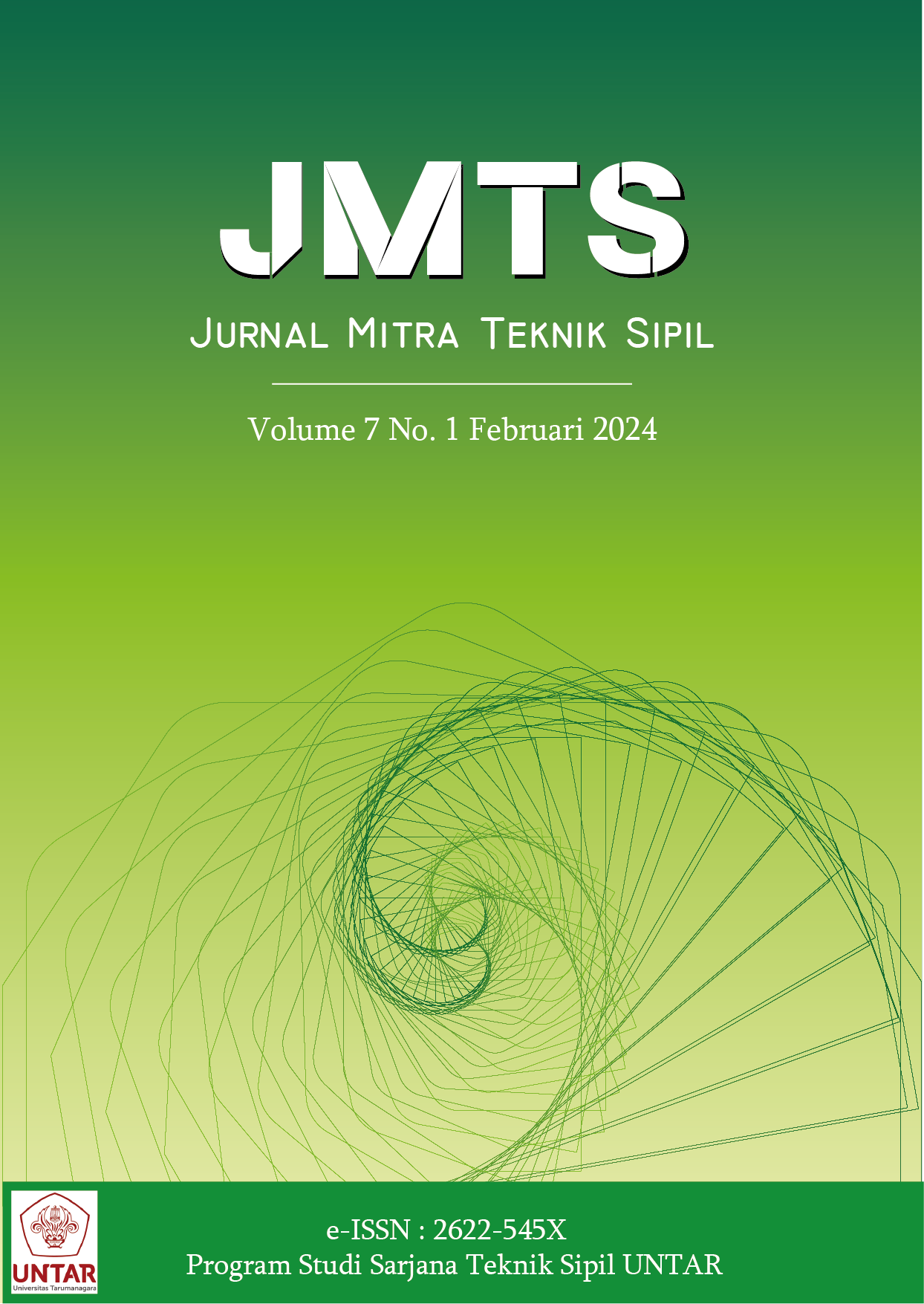EVALUASI PENGGUNAAN RANGKA BAJA HOLLOW SEBAGAI SISTEM PENYANGGA BEKISTING PLAT LANTAI PADA PROYEK X
Main Article Content
Abstract
In the construction industry, the protection of formwork is a crucial aspect in designing and constructing sturdy and safe structures. Therefore, the success of an effective and efficient formwork support system plays a crucial role in ensuring the safety of the structure. One solution implemented in this industry is the use of hollow steel (square-shaped pipes) as a formwork support system for floor plates. This study presents the results of the analysis of hollow steel used in construction, particularly in buildings. The research aims to determine the ability of hollow steel in supporting the load of floor formwork. Data collection methods involve observation, interviews, and testing using a structural analysis program to determine the strength of hollow steel in supporting the load of floor formwork. The research results indicate that the hollow steel frame has a deflection of 0.0641 m, where the deflection is still below the maximum allowable limit. The hollow steel frame produces balanced lateral forces and moment forces, making it safe for use. However, the strength ratio of the steel frame does not meet the requirements due to a strength ratio greater than 1. Therefore, additional support is needed in the middle of the floor plate.
Abstrak
Dalam industri konstruksi, perlindungan terhadap bekisting merupakan aspek yang sangat krusial dalam merancang dan membangun struktur yang kokoh dan aman. Oleh karena itu, keberhasilan sistem penyangga bekisting yang efektif dan efisien memiliki peran yang sangat penting dalam memastikan keselamatan struktur. Salah satu solusi yang telah diimplementasikan di dalam industri ini adalah penerapan baja hollow (pipa berbentuk kotak) sebagai sistem penyangga bekisting plat lantai. Studi ini menyajikan hasil analisis baja hollow yang digunakan dalam konstruksi khususnya pada bangunan. Penelitian ini bertujuan untuk mengetahui kemampuan baja hollow dalam menahan beban bekisting plat lantai. Metode pengumpulan data dilakukan dengan melakukan pengamatan dan melakukan wawancara, serta untuk metode pengujian dilakukan dengan menggunakan salah satu program analisis struktur untuk menentukan kekuatan baja hollow dalam menahan beban bekisting plat lantai. Hasil penelitian menunjukkan bahwa rangka baja hollow memiliki lendutan sebesar 0,0641 m dimana besar lendutan yang terjadi masih di bawah batas maksimum lendutan yang diperbolehkan dan rangka baja hollow menghasilkan gaya dalam lintang dan gaya dalam momen yang seimbang, sehingga rangka hollow aman untuk digunakan. Namun rasio kekuatan dari rangka baja belum memenuhi persyaratan karena terdapat rasio kekuatan yang lebih besar dari pada 1, maka diperlukan penyangga tambahan pada bagian tengah plat lantai.
Article Details

This work is licensed under a Creative Commons Attribution-NonCommercial-ShareAlike 4.0 International License.
This work is licensed under Jurnal Mitra Teknik Sipil (JMTS) Creative Commons Attribution-ShareAlike 4.0 International License.References
Badan Standarisasi Nasional. (2002). SNI 03-1729-2002. Tata Cara Perencanaan Struktur Baja Untuk Gedung. Jakarta
Dieter, G. E. (1998). Mechanical Metallurgi. Mc Graw Hill.
Ervianto, W. I. (2006). Eksplorasi Teknologi Dalam Proyek Konstruksi (Beton Pracetak & Bekisting). Andi Offset.
Khanna, S. (2022, March 1). The importance of Hollow Steel Structures in modern construction. Medium. https://medium.com/@sejalbatrakhanna/the-importance-of-hollow-steel-structures-in-modern-construction-fba041971499
Wijaya, J. M. (2022). Analisis Kekuatan Mekanis Besi Hollow Baja Ringan C-4130= APL C-4130 Mild Steel Hollow Strength Mechanical Analysis [Skripsi Sarjana, Universitas Hasanuddin].
Dewobroto, W. (2014, February 21). Capacity Ratio lebih dari 1, boleh pak? https://wiryanto.blog/2014/02/21/capacity-ratio-lebih-dari-1-boleh-pak/



